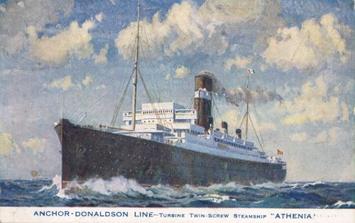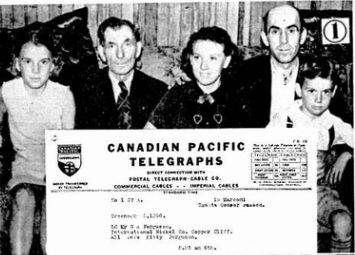Sinking of the Athenia
The Athenia was the first ship sunk by a U-boat in the Second World War. This attack was carried out in contravention of standing orders.
The first shots of the Battle of the Atlantic was fired on September 3, 1939, by Fritz Julius Lemp of U-30, a Type VIIA U-boat while on patrol in the northwestern sector of Ireland. At 19.39 hours on September 3, 1939, the unescorted and unarmed Athenia (Master James Cook) was torpedoed without warning by U-30 about 250 miles west of Inishtrahull. One torpedo struck on the port side in the engine room, causing the ship to sink at 10.00 hours on September 4th.
Most of the 315 crew members and 1103 passengers abandoned ship in 26 lifeboats. 19 crew members and 93 passengers were lost. Many of them died when one lifeboat, carrying 52 female passengers and three sailors came, due to the darkness, in contact with the propeller of the Norwegian motor merchant Knute Nelson (Master Carl Johan Anderssen) and capsized, only eight survived. The Norwegian vessel had been the first ship on the scene, picked up 449 survivors and landed them at Galway on September 5th. The Swedish motor yacht Southern Cross picked up 376 survivors and later transferred 236 of them to the City of Flint (Master Joseph A. Gainard) which landed them at Halifax. HMS Electra (H 27) (LtCdr S.A. Buss, RN) and HMS Escort (H 66) (LtCdr J. Bostock, RN) picked up the remaining survivors and landed them at Greenock on 5 September.
The first shots of the Battle of the Atlantic was fired on September 3, 1939, by Fritz Julius Lemp of U-30, a Type VIIA U-boat while on patrol in the northwestern sector of Ireland. At 19.39 hours on September 3, 1939, the unescorted and unarmed Athenia (Master James Cook) was torpedoed without warning by U-30 about 250 miles west of Inishtrahull. One torpedo struck on the port side in the engine room, causing the ship to sink at 10.00 hours on September 4th.
Most of the 315 crew members and 1103 passengers abandoned ship in 26 lifeboats. 19 crew members and 93 passengers were lost. Many of them died when one lifeboat, carrying 52 female passengers and three sailors came, due to the darkness, in contact with the propeller of the Norwegian motor merchant Knute Nelson (Master Carl Johan Anderssen) and capsized, only eight survived. The Norwegian vessel had been the first ship on the scene, picked up 449 survivors and landed them at Galway on September 5th. The Swedish motor yacht Southern Cross picked up 376 survivors and later transferred 236 of them to the City of Flint (Master Joseph A. Gainard) which landed them at Halifax. HMS Electra (H 27) (LtCdr S.A. Buss, RN) and HMS Escort (H 66) (LtCdr J. Bostock, RN) picked up the remaining survivors and landed them at Greenock on 5 September.
|
Injured List from Athenia who were admitted to Western Infirmary Glasgow.
The fact that these Survivors from Athenia were landed in Scotland indicates they were rescued by one of the three British Destroyers, HM ships, Electra, Escort or Fame. Kathleen Ferguson - Copper Cliff, Ontario. http://ahoy.tk-jk.net/macslog/SurvivorsfromAtheniarescu.html Survivors Listed at Glasgow from The Pittsburgh Press September 5, 1939 “Kathleen Ferguson, Copper Cliff, Ontario back injury and shock” |
September 6, 1939 The Globe and Mail “New List of Survivors Is Issued by Admiralty – G. A. Ferguson of Copper Cliff received a cablegram today informing him his wife and two daughters, Kathleen, 9, and Margaret, 3, were safe.”
September 22, 1939 The Globe and Mail “163 Athenia Survivors Are Brought to Quebec Survivors of the torpedoed liner Athenia, all but three of them Canadians reached Quebec today and continued to Montreal where they are due to arrive late this evening.” |
|
“Loved Ones Safe With shocking swiftness the full realization of war came home to Nickel District residents when news was received that among the passengers on the liner Athenia, victim of a cruel and heartless enemy submarine attack, were the wife [Kathleen] and two daughters [Kathleen 9 and Margaret 3] of George Ferguson, Copper Cliff electrical worker. For two days and two nights Mr. Ferguson and the three children who remained at home with him frantically sought news of the welfare of their loved ones, or sat in quiet desperation beside their radio awaiting some glimmer of hope. Finally they got the message for which they prayed: All safe, Kitty Ferguson."
|
April 07 - An Email: Just read your article with pleasure – my mother Kathleen Ferguson and sisters Kathleen Ferguson (aged 9) and Margaret (almost 3) where on the ill-fated ship returning to Canada after visiting family in South Shields. Margaret is still living. I believe there was a photo of her being rescued by a seaman in the Toronto Star (he has her tucked into his life vest). I believe that they were rescued by a destroyer and taken to Glasgow. My mother had a back injury. Her greatest fear in the weeks following were of having to set out again across the Atlantic with two children. My mother said that they never went below deck on the second voyage. It must have been very cold to travel the North Atlantic at the end of October in blackout. My father waited for news of their survival for days and at first only one Kathleen Ferguson was listed because it was thought that there was a duplication. I will be ordering your book. Thanks so much – Gwen Chmilar. http://www.secondworldwar.org.uk/athenia.html


